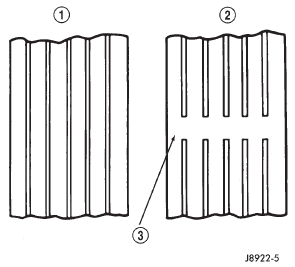 Jeep Cherokee Service ManualTires and wheels » Tires
Jeep Cherokee Service ManualTires and wheels » Tires
Diagnosis and testing
Diagnosis and testing
Pressure gauges
A quality air pressure gauge is recommended to check tire pressure. After checking the air pressure, replace valve cap finger tight.
Tread wear indicators
Tread wear indicators are molded into the bottom of the tread grooves. When tread depth is 1.6 mm (1/16 in.), the tread wear indicators will appear as a 13 mm (1/2 in.) band (Fig. 4).
Tire replacement is necessary when indicators appear in two or more grooves or if localized balding occurs.
Tire wear patterns
Under inflation will cause wear on the shoulders of tire. Over inflation will cause wear at the center of tire.
Excessive camber causes the tire to run at an angle to the road. One side of tread is then worn more than the other (Fig. 5).
Excessive toe-in or toe-out causes wear on the tread edges and a feathered effect across the tread (Fig. 5).
Tire noise or vibration
Radial-ply tires are sensitive to force impulses caused by improper mounting, vibration, wheel defects, or possibly tire imbalance.
To find out if tires are causing the noise or vibration, drive the vehicle over a smooth road at varying speeds. Note the noise level during acceleration, deceleration and slight left and right steering inputs.

Fig. 4 Tread Wear Indicators
1 - THREAD ACCEPTABLE
2 - THREAD UNACCEPTABLE
3 - WEAR INDICATOR
Description and operation
Diagnosis and testing
Service procedures
Cleaning and inspection
Specifications
Jeep Cherokee Service Manual
- Lubrication and maintenance
- Suspension
- Differential and driveline
- Brakes
- Clutch
- Cooling system
- Battery
- Starting systems
- Charging system
- Ignition system
- Instrument panel systems
- Audio systems
- Horn systems
- Speed control system
- Turn signal and hazard warning systems
- Wiper and washer systems
- Lamps
- Passive restraint systems
- Electrically heated systems
- Power distribution systems
- Power lock systems
- Vehicle theft/security systems
- Power seat systems
- Power window systems
- Power mirror systems
- Chime/buzzer warning systems
- Overhead console systems
- Engine
- Exhaust system
- Frame and bumpers
- Frame
- Fuel system
- Steering
- Transmission and transfer case
- Tires and wheels
- Body
